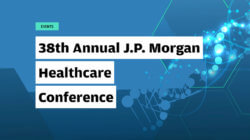February 17, 2020

Chadwick Annual Synthesis: A Look Inside
(from Taking Healthcare’s Pulse: 4sight Health’s 2020 J.P. Morgan Conference Report)
Chadwick Annual Synthesis: A Look Inside J.P. Morgan 2020

By Edward Chadwick, Founder of Integrated Healthcare Financial Strategies LLC
The following is a synthesis of the tax-exempt track at the January 2020 J.P. Morgan Healthcare Investor Conference held in San Francisco on January 13-16, 2020. This narrative highlights common themes, organizations pushing the edge on transformation, and some thoughts on what was not discussed but should have been. This was the 10th year of the tax-exempt track and 38th year overall for the annual conference. This writeup focuses on the tax-exempt sessions, although there were almost 450 presentations by investor-owned organizations that are also trying to change the future of healthcare.
Common Themes
There was much passion, humility and celebration of what progressive health systems are doing to better meet the needs of their communities. When watching 27 presentations by leading health systems, many common themes emerge, as we all face similar industry challenges and opportunities. Leadership teams and boards can look at the following list as another data point to test their own playbooks. While most core strategies have continued over the last several years, this write-up also comments on trending of focus compared to presentations at prior conferences.
Patient/consumer centricity and experience continue to be a commitment for all systems, with even more emphasis on putting the patient and their families at the center of care and business model redesign and strategic focus. There is growing emphasis on moving care closer to the patient through ambulatory growth and virtual means, and out of traditional inpatient settings.
Safety and quality improvements are a continued expectation for all systems, with some systems committed to being High Reliability Organizations with zero serious safety events.
Growth, scale and diversification remain top priorities for most systems, although approach, pace and value proposition vary across entities and markets. While there is still enormous value to be tapped, some systems are truly differentiating themselves at a pace not seen previously.
Affordability of healthcare is a widespread concern, with broad recognition that the current system is already unaffordable.
Efficiency and performance improvement continue to be important for most systems to offset the gap between payment rate increases and input inflation. Many systems are proud that they leverage business discipline and push for wide adoption of evidence-based practice.
Value-based care and population health received more discussion than in recent years, with many health systems describing benefits of having their own health plans, expanded Medicare Advantage participation, risk-based contracts, direct-to-employer relationships and ongoing programs to reduce PMPM costs.
Transformation, disruption and innovation are driving many health systems that believe they must accelerate transformation before others disintermediate them. While discussed in prior years, urgency and effort to push for transformation appear to be increasing.
Digital enablement, including virtual care, data analytics, AI and robotic process automation (RPA) are now uniformly discussed as essential to better serve patients and members, although healthcare still lags other industries.
Genetics and precision medicine are growing as strategic priorities, particularly for cancer care. Multiple organizations are now pursuing full genome sequencing for large numbers of individuals in their communities, and technologies such as CAR-T therapies, CRISPR and regenerative medicine have moved from research to care delivery.
Partnerships and commercialization are expanding in popularity as ways to gain access to additional capabilities and accelerate transformation. This includes partnerships with Google and Microsoft, as well as a plethora of relationships to improve care, patient experience or cost structure. Health systems are expanding efforts to commercialize their own perfected administrative capabilities and discoveries.
Social Determinants of health receive wide recognition, as health systems need to partner with other organizations and engage with individuals differently to improve health in their communities.
Unwavering Mission Commitment describes many organizations. This includes providing care for at risk populations as reflected in community benefit spending, the obligation to maximize impact on communities served, as well as investments in teaching the health professionals of tomorrow and care discovery.
Culture and commitment to employees continue as areas of focus, including diversity and inclusion, talent development, and more recently, broader commitment to caregiver well-being.
Treasury management remains important as most organizations are half bank and half operating unit based on the respective size of assets and cash flow. Balance sheets generally strengthened in 2019 as a result of strong investment gains and solid operating performance.
Common Electronic Medical Records (EMRs) play a critical part of standardizing high-quality care, but discussions about EMRs had less prominence than in prior conferences.
Organizations “pushing the edge” — presenting tax-exempt systems ranged in size from sub-$2 billion to $30 billion of revenue. They included regional and national systems, health systems with robust academic missions, integrated plan/provider systems, and specialty organizations. Some benefit from being in high growth markets, others are in stable or declining markets. All face a rapidly changing healthcare environment. Each organization had 25 minutes to succinctly share their situation, strategies and successes. A synthesis of the presentations by those moving particularly fast to transform is included in the full report.
Critical issues not addressed at the conference given time constraints and general desire to tell a positive story in front of peers, prospective partners and the financial community, it is not unreasonable for leaders to focus on “the good stuff” and avoid “uncomfortable truths.” Sometimes that is unfavorable financial performance, more broadly it is about industry exposures. Two industry issues not really discussed but critical to future viability are risk of major future payment reductions, and the fact that the industry remains massively subscale. Both of those topics have enormous future ramifications and are discussed in more detail in the full report.
Co-author

Edward Chadwick, Founder of Integrated Healthcare Financial Strategies, LLC wrote this report. He has historically drafted a summary of both the annual JPM and Citi/AHA/HFMA Healthcare Investor Conferences. Mr. Chadwick has been system CFO of a national Catholic System (Trinity Health), a top-20 academic health system (Wake Forest), and a fully integrated plan/provider (Henry Ford Health System). He holds an MBA from the University of Chicago Booth School of Business. He can be contacted at edward.chadwick@ihfstrategies.com or linkedin.com/in/edward-chadwick.





